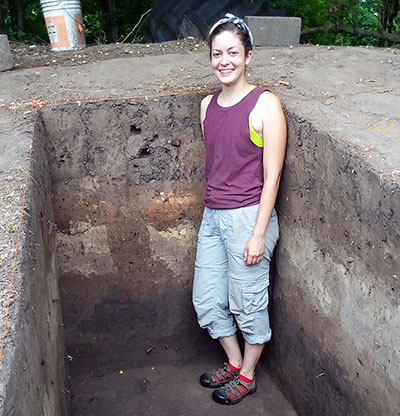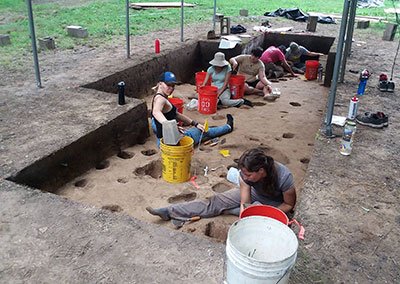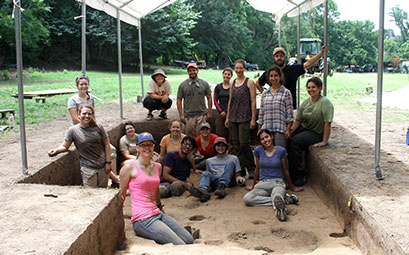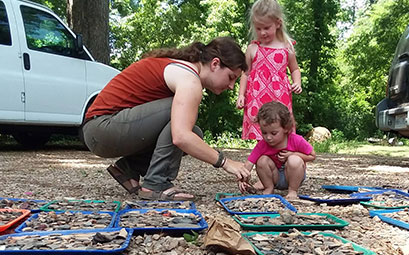Smith Creek Archaeological Project
Curatorial Section
Research Discipline
Archaeology
Expand Global Research
Over more than a century, we’ve opened up endless exploration across six continents. New field work endowments will ensure our continued leadership in national and international field research and discovery.
Give Now- Project Summary
-
The Smith Creek Archaeological Project (SCAP) focuses on prehistoric mound-building populations in the Lower Mississippi River Valley. The Mississippi River played a defining role in the prehistory of the eastern United States. Due to the natural abundance of the river and its associated floodplains, the Lower Valley region has always been advanced in terms of monumental constructions and is home to thousands of earthen mounds. These mounds demonstrate high levels of variation in terms of form, size, and elaboration and have given rise to many unresolved debates as to their functions and meanings. Smith Creek is a mound site in southwestern Mississippi constructed during Coles Creek times (700 – 1200 CE). Like many contemporary sites, Smith Creek consists of three earthen monuments surrounding an open plaza. Due to similarities with later sites, this layout has often been interpreted as representing chiefly villages reliant on corn agriculture. However, recent work at Coles Creek sites and re-analyses of excavated material have suggested that these early mound-and-plaza centers may have been locations for communal feasting and ritual activities aimed at bringing together a dispersed, largely egalitarian population.
Beginning in 2015 under the direction of Dr. Megan Kassabaum, SCAP excavations revealed that Smith Creek’s occupation spanned the transition from Coles Creek to the later Plaquemine culture and thus might also span the transitions from egalitarian to hierarchical social organization, from hunting and gathering to agriculture, and from vacant ritual centers to elite villages. Excavations focus both on and off the mounds in order to understand the range of activities taking place at the site and recent excavations have revealed a very early occupation between two of the mounds.
Excavations at the site will resume in next summer. The project involves a large number of Penn graduate and undergraduate students both in the field and in the lab where the excavated materials are housed.
- New Findings
-
Analysis of excavated materials revealed significantly earlier occupation.
Previous excavation of the Smith Creek site suggested that the mounds were constructed by the Coles Creek culture (750-1200 CE), while the site served as a residential community for later Plaquemine people (1200-1350 CE). In 2017, material collected during the 2015 and 2016 excavations was analyzed and unexpectedly revealed evidence of significantly earlier occupation in the northeastern plaza of Smith Creek. It now appears that the first use of the site was around 500 years earlier than previously believed, dating to the Tchefuncte culture (ca. 350-100 BCE).
2018 Excavations
To better understand this early occupation, much of the 2018 excavation concentrated in the northeastern plaza, where the earlier Tchefuncte material had previously been discovered. Here, the archaeologists discovered dense trash deposits of ceramics, stone tools, and food remains left behind by the Plaquemine occupation. This deposit superimposes an enormous, circular structure that is likely a Tchefuncte ceremonial building. This discovery suggests that the site served as a persistently important place for nearly a millennium, representing one of the earliest ceremonial landscapes in the region. Studying this long history will help archaeologists to better understand the relationship between the various pre-contact cultures that occupied the Lower Mississippi Valley and perhaps the origins of moundbuilding in southwest Mississippi.
SCAP Exhibition
The team will return to the site in 2019 to continue excavations and open a new exhibition in the Wilkinson County Museum. The exhibition, co-curated by Dr. Megan Kassabaum and Penn Museum Fellow, Arielle Pierson, will summarize the archaeology of the region and share with the local community information learned in the excavation of the mound site, making connections between the past and present landscape of the Lower Mississippi Valley.
- Location Information
-
Tchefuncte, Coles Creek, and Plaquemine cultures thrived in the fertile Lower Mississippi Valley region of the American South. Smith Creek is located in Wilkinson County in far southwestern Mississippi and sits along bluffs overlooking the Mississippi River. The site is located along the route of the Mississippi Mound Trail.
- Time Period Studied
-
The Smith Creek Archaeological Project (SCAP) focuses on a Native American mound-and-plaza center that was constructed by Coles Creek people (700-1200 CE) and later occupied by Plaquemine people (1200-1350 CE). Recent excavations have also revealed an earlier occupation by Tchefuncte people (ca. 200 BCE).
- Resources & More Information
-
- North American Archaeology Lab
- Moundbuilders: Ancient Architects of North America
- Monumental Grandeur of the Mississippi Valley
- SCAP Blog Posts
- SCAP Videos
- SCAP Podcasts
- To keep up with the latest updates, follow SCAP on Facebook.
The Smith Creek Archaeological Project (SCAP) focuses on a pre-contact Native American mound site in the Lower Mississippi River Valley. The site served as an important ritual center for over 1000 years. Research at the site focuses on the complex relationships that existed between monument construction and identity, as well as foodways and politics through archaeological excavation and analysis of the recovered materials.
People Associations










